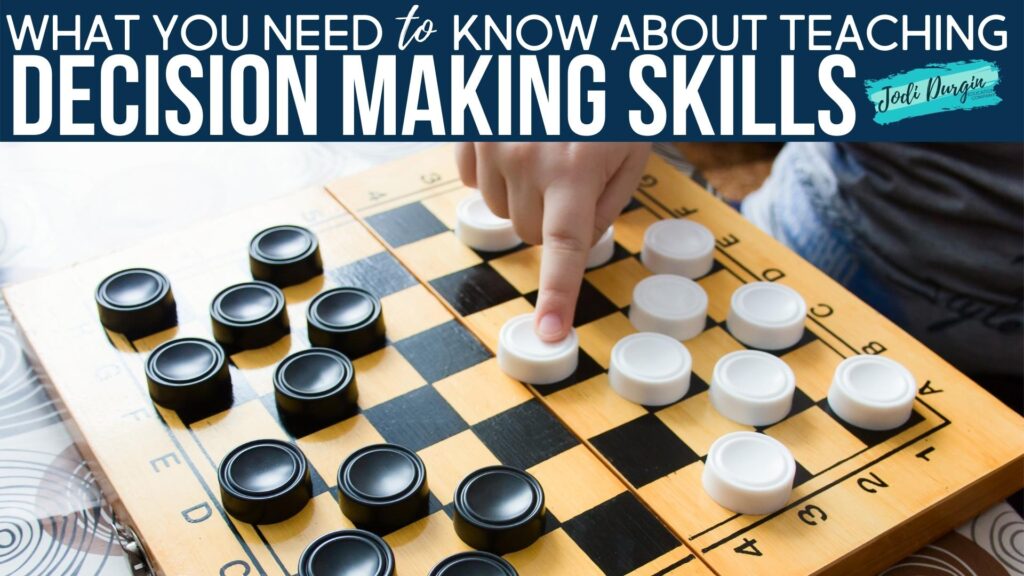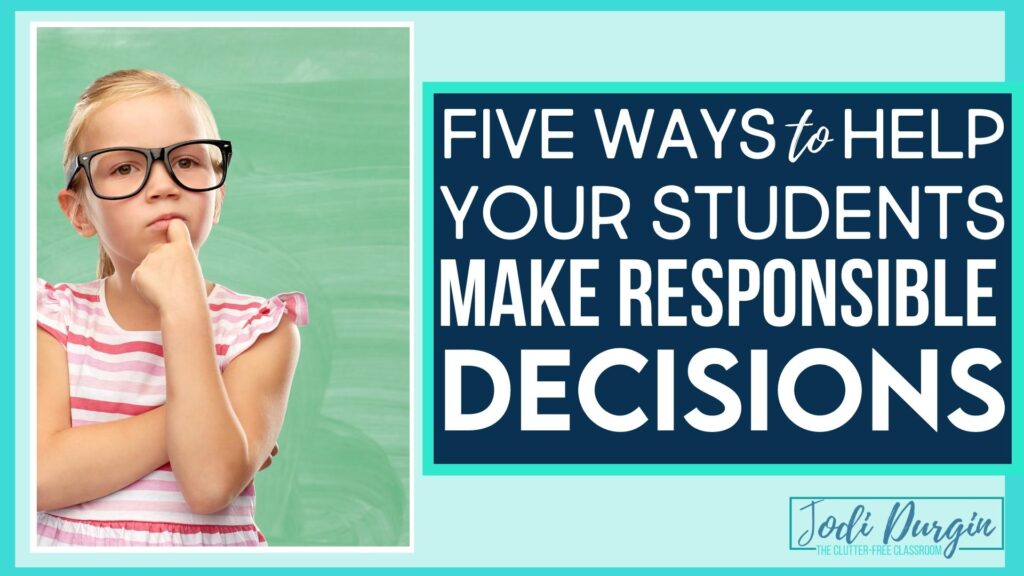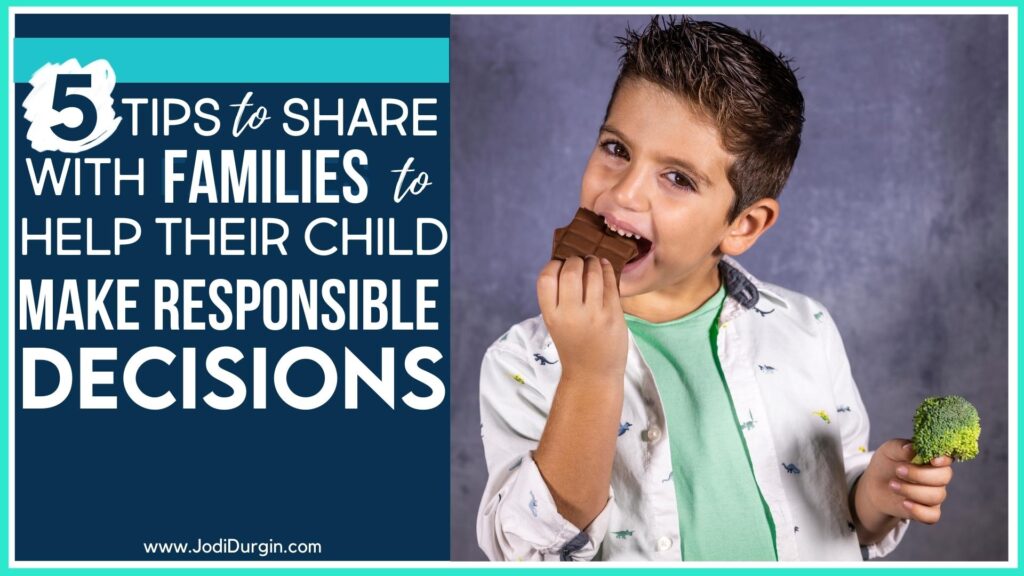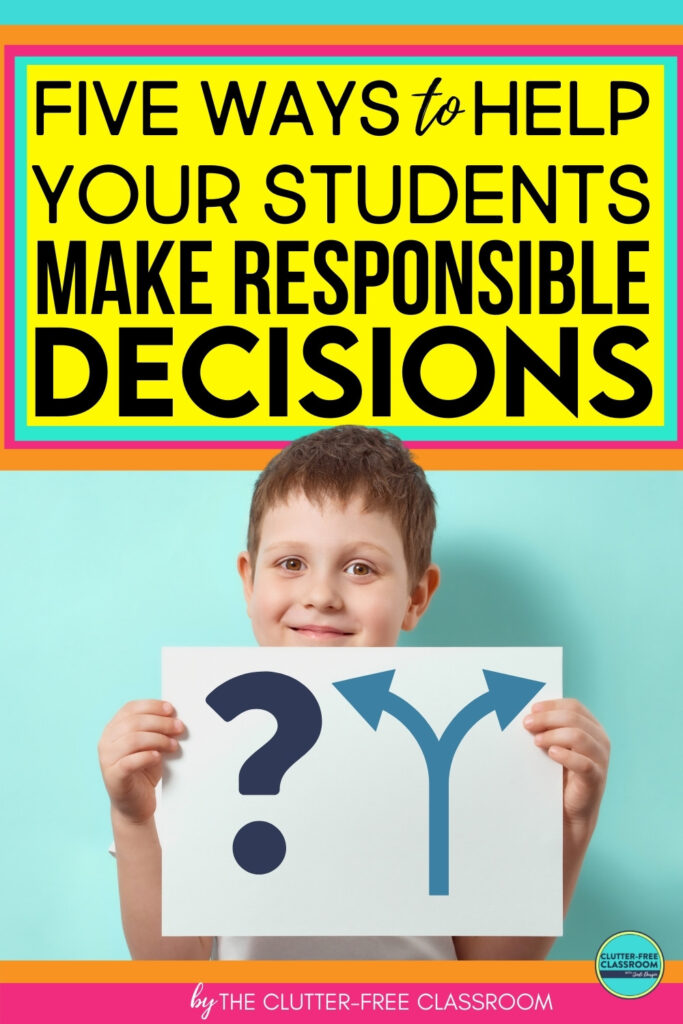If you are an elementary teacher looking for tips and ideas for teaching responsible decision making skills, then you found the right place! This post includes tons of information about the SEL topic, responsible decision making.
The Collaborative for Academic, Social, and Emotional Learning (CASEL) created a social emotional learning (SEL) framework. This SEL framework includes five core competencies – one of which is responsible decision making. Teaching responsible decision making skills is an essential part of social emotional learning curriculum.
This post answers the following questions teachers have about teaching responsible decision making:
- What is responsible decision making?
- Why is teaching responsible decision making skills important?
- How can I help my students improve their responsible decision making skills?
- What are some tips I can share with my students’ families about helping their child improve their responsible decision making skills?

What is Responsible Decision Making?
Responsible decision making is the ability to make good choices about personal behavior and social interactions. The constructive choices that students make should be based on ethical standards, safety concerns, and social norms. When making the decision, the realistic evaluation of the consequences of different actions, and a consideration of the well-being of oneself and others should be included in the decision making process. Responsible decision making doesn’t just come down to students being able to make a decision. A lot of work and learning goes into students being able to make decisions that they have evaluated and that they believe has the best solution.
Why is Responsible Decision Making Important?
Responsible decision making is so important because it fosters the ability to make positive choices about how we behave. Students being able to solve their own problems also gives them confidence and fosters independence. In addition, them being able to solve their own problems supports the belief that they can do difficult things, which is called self-efficacy. Students will be on the path to success by being able to solve their own problems and make responsible decisions.

A Deeper Dive into Responsible Decision Making
Below is more information to know before teaching responsible decision making to your students.
Identifying Problems
Being able to recognize when you are having a problem is the first step in making responsible decisions, so it is important for students to acknowledge when they are having a problem. This can be difficult for some students based on their prior knowledge and background.
Analyzing Situations
When students have identified the problem, they then need to learn to analyze the situation from different angles. This means looking at how and why the problem happened. Students will sometimes require help from an adult in determining how the problem happened and the student’s role in the problem.
Solving Problems
Once students have identified the problem and have analyzed what caused the problem, they are ready to solve the problem. Students should identify different solutions to the problem they are facing and think about the different consequences and outcomes of different solutions and use this information to pick the best solution. Students will need support from the teacher in this area.
Evaluating
After choosing the best solution and acting on it, students need to evaluate whether or not the solution was successful. They also need to evaluate their performance going through the problem solving steps and what was successful and what they still need to work on.
Reflecting
At the end of the process of making responsible decisions, students need to reflect on the problem they had, how they chose to solve it, and the effect of the solution. Students may need help working through these steps because it can be difficult for them to see their role in the problem and whether or not the solution was really the best for everyone. They will be tempted to only see it as best for them.
Ethical Responsibility
When thinking about the consequences of the solution they chose, students need to determine any ethical or moral considerations that are involved in the solution. This is something that students, especially elementary and primary, will need support in as this isn’t a process that will come naturally to them. Having conversations with students about what ethical means will be important before students do this step.

5 Strategies for Helping Kids Improve Responsible Decision Making Skills
Below are 5 teaching strategies for helping students improve their responsible decision making skills.
1. Role play
Role play is critical for helping students develop the problem solving steps. Students working through the problem solving steps when they only have hypothetical problems makes them better equipped to solve problems when they are actually experiencing them. Role play is also a great way to practice evaluating the ethical responsibility of solutions and reflect on the effectiveness of students going through the problem solving steps. Similar to before, when students are reflecting on hypothetical solutions, they are more likely to have an open mind when reflecting on the effectiveness. These SEL units include role playing activities.
2. Modeling
Model yourself making responsible decisions. Name the problem that you are having for your students, model analyzing what caused the problem and your role in it, work through choosing the best solution for your problem, and evaluating and reflecting on the effectiveness of the solution.
3. Morning meeting
Work solving problems into your morning meeting. You could have a problem of the day to solve and have the students work through the problem solving steps as a whole class. Practicing solving problems this way is a relaxed way for students to practice working through the problem solving steps.
4. Journaling
Journals are a great way to have students evaluate and reflect how they were able to make responsible decisions. You can make journaling a practice that students complete after making a responsible decision or solving a problem. This way you can also see how the students worked through the decision making process and where they may need reteaching.
5. Reader’s theaters
Reader’s theaters and other skits are an engaging way for students to practice making decisions and solving problems. Call attention to the parts where the characters are experiencing a problem and pause to discuss different solutions to the problem. Have your students reflect on whether or not their characters chose the same solution that they would have.

5 Tips for Families
Reach out to your students’ families after introducing and teaching responsible decision making in class. Below are 5 tips you can share with them about responsible decision making.
1. Give your child responsibility
Your child can’t grow as a responsible decision maker if they don’t have opportunities to make decisions. Let them decide what to wear, make them responsible for cleaning their room, or have them pack their own lunch or snack.
2. Talk about problems
Talk about problems that you had in your day and how you solved them. Ask your child about their day and if they had any problems that they solved. Create a comfortable environment that fosters independent problem solving but allows your child to come to you to reflect.
3. Talk about values
Part of making responsible decisions involves looking at the ethics of the problem and various decisions and what consequences there could be. Home is a great, safe place to brainstorm with your child about what they find to be important and explore what their values may be.
4. Allow your child to make mistakes
If you take away all barriers for your child and don’t allow them to make mistakes then they will not have any problems to solve. Not having any problems sounds like a great idea, but it doesn’t prepare children to handle difficult situations. So many lessons can be learned in having a problem and solving it. Your child will gain confidence in their ability to do so.
5. Initiate book talks
While reading with your child, pause to ask what problems the character is having. Brainstorm ways that they could solve their problem and predict what the character will do. Pause at the different problem solving steps throughout the book. Reflect on if the character chose the solution to their problem that you thought they would and if you agree or disagree.
We hope you found this post about teaching responsible decision making to elementary students helpful! If you did, you may also be interested in these other SEL competency blog posts for teaching self awareness, self management, relationship skills, and social awareness.


